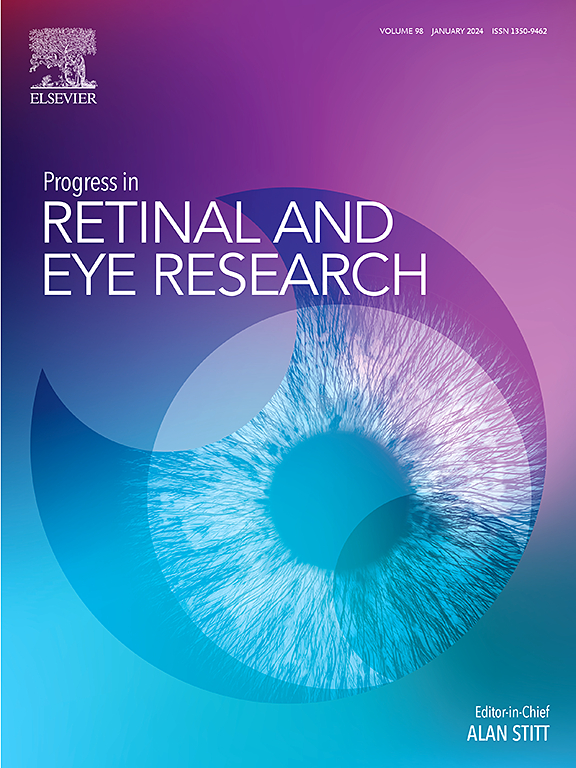表征布鲁赫膜:视网膜疾病和健康中的最先进的成像、计算分割和生物模型
IF 18.6
1区 医学
Q1 OPHTHALMOLOGY
引用次数: 0
摘要
布鲁氏膜(BM)是一种位于脉络膜和视网膜色素上皮(RPE)之间的细胞外基质。BM在视网膜健康中起着至关重要的作用,发挥着包括生物分子扩散和RPE支持在内的各种功能。基底膜也与许多视网膜疾病有关,对基底膜功能障碍的了解有助于进一步了解各种视网膜病理的病理生理学。因此,BM的表征是进一步了解其在视网膜疾病中的作用的一个重要研究领域。在本文中,我们提供了各种进展的回顾表征和可视化BM。我们提供了视网膜健康的BM的概述,以及在衰老和疾病中观察到的变化。然后,我们描述了当前最先进的成像方式和进一步可视化BM的进展,包括各种类型的光学相干断层成像,近红外反射(NIR),自体荧光成像和组织基质辅助激光解吸/电离成像质谱(MALDI-IMS)。随着脑基成像的进展,我们描述了动物、细胞和合成模型,这些模型已经开发出来,可以进一步可视化脑基。在本节之后,我们概述了视网膜成像中的深度学习,并描述了计算和人工智能(AI)技术的进展,以提供BM和BM开口的自动分割。我们总结本节考虑到这些分割技术的临床意义。最终,旨在进一步表征基底膜的各种进展可能会让我们更深入地了解这一关键结构在视网膜健康和疾病中的作用。本文章由计算机程序翻译,如有差异,请以英文原文为准。
Characterizing Bruch's membrane: State-of-the-art imaging, computational segmentation, and biologic models in retinal disease and health
The Bruch's membrane (BM) is an acellular, extracellular matrix that lies between the choroid and retinal pigment epithelium (RPE). The BM plays a critical role in retinal health, performing various functions including biomolecule diffusion and RPE support. The BM is also involved in many retinal diseases, and insights into BM dysfunction allow for further understanding of the pathophysiology of various chorioretinal pathologies. Thus, characterization of the BM serves as an important area of research to further understand its involvement in retinal disease. In this article, we provide a review of various advancements in characterizing and visualizing the BM. We provide an overview of the BM in retinal health, as well as changes observed in aging and disease. We then describe current state-of-the-art imaging modalities and advances to further visualize the BM including various types of optical coherence tomography imaging, near-infrared reflectance (NIR), and autofluorescence imaging and tissue matrix-assisted laser desorption/ionization imaging mass spectrometry (MALDI-IMS). Following advances in imaging of the BM, we describe animal, cellular, and synthetic models that have been developed to further visualize the BM. Following this section, we provide an overview of deep learning in retinal imaging and describe advances in computational and artificial intelligence (AI) techniques to provide automated segmentation of the BM and BM opening. We conclude this section considering the clinical implications of these segmentation techniques. Ultimately, the diverse advances aimed to further characterize the BM may allow for deeper insights into the involvement of this critical structure in retinal health and disease.
求助全文
通过发布文献求助,成功后即可免费获取论文全文。
去求助
来源期刊
CiteScore
34.10
自引率
5.10%
发文量
78
期刊介绍:
Progress in Retinal and Eye Research is a Reviews-only journal. By invitation, leading experts write on basic and clinical aspects of the eye in a style appealing to molecular biologists, neuroscientists and physiologists, as well as to vision researchers and ophthalmologists.
The journal covers all aspects of eye research, including topics pertaining to the retina and pigment epithelial layer, cornea, tears, lacrimal glands, aqueous humour, iris, ciliary body, trabeculum, lens, vitreous humour and diseases such as dry-eye, inflammation, keratoconus, corneal dystrophy, glaucoma and cataract.

 求助内容:
求助内容: 应助结果提醒方式:
应助结果提醒方式:


